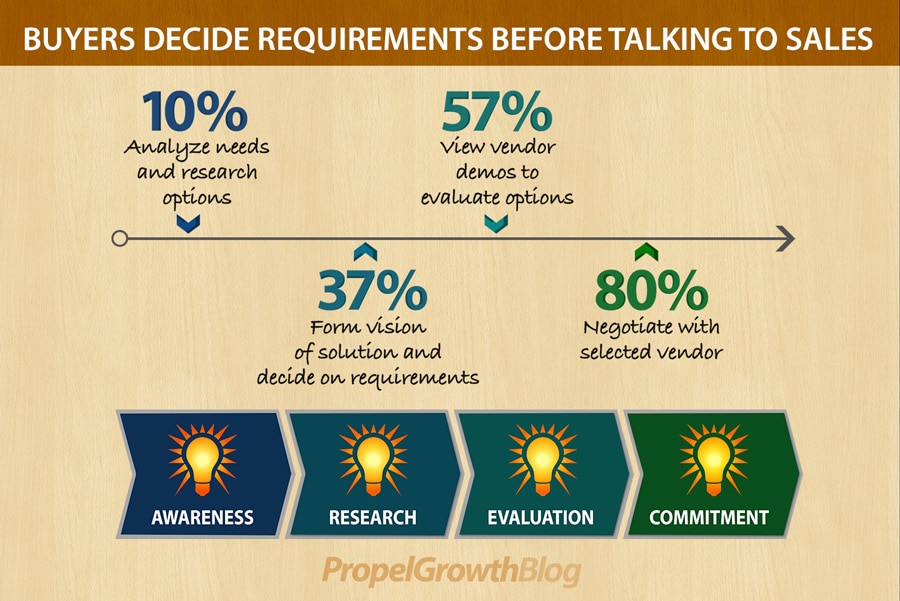
Is top line growth a key objective for your firm this year? If so, then a content marketing strategy is a crucial component of your sales and marketing plans.
Recent research from CEB found that on average, buyers are framing their concept of a solution and deciding on requirements when they’re only 37% of the way through their buying process. However, they generally won’t engage with Sales until they’re 57% of the way through their process. That means they’re making key decisions about requirements and features BEFORE they meet with your sales team.
The way buyers buy has changed, so the way you market also needs to change, if you want to ensure that your offering gets due consideration.
Most Companies are Failing at Content Marketing
Content marketing is the solution to this problem, but 70% of B2B companies are not succeeding with their content marketing efforts. Most fin-tech vendors are doing some form of content marketing. But their approaches are rarely driven by a well-thought-through content marketing strategy. Consequently, they publish a lot of content without getting the results they’re hoping for. In their 2016 study, Content Marketing Institute found that only 30% of B2B marketers say their organizations are effective at content marketing. CMI’s research consistently shows that “those who document their strategy are more effective in nearly all areas of content marketing.”
Turbulent economic times and shifting buying behavior expose weak marketing strategies. If your revenues are not where you want them to be, then it’s time to refresh your strategy.
What Goes Into a Content Marketing Strategy?
Your strategy should document detailed buyer insights (their situation, needs, trigger events and buying journey), buyer-centric positioning and messaging, and your strategy for reaching those buyers. It should include details about the following:
- Sales goals, revenue targets, and expected 1st year and lifetime customer value
- Detailed customer descriptions including:
- Economic, business and social trends impacting your customers
- Target business demographics, situations and needs
- Common triggers that cause your targets to initiate a buying process
- Buyer personas, buyer journeys, and customer-centric messaging to target each persona
- Your inherent strengths and weaknesses in the context of customer needs, the competitive marketplace, and the trends described above
- Competitive analysis, how your offering is differentiated and competitive messaging
- Buyer-centric messaging and positioning of the services and products you offer
- Plans for how you will reach your target audience via outbound marketing, events, digital channels, sales outreach, social media, etc.
- Pricing and anticipated ROI for different customer segments and needs
- Metrics you’ll use to track effectiveness and strategies for optimization
It should show how you plan to capitalize on economic, business and social trends affecting your customers. It should address the competitive environment, your relative advantages and disadvantages, your competitive positioning and your differentiation based on buyer requirements and expectations. Finally, it should include an overall content strategy, a plan for marketing channels, and your approaches for an integrated inbound and outbound marketing plan.
| [ Read More: How to Create a Strategy Canvas for Competitive Positioning ] |
The strategy also needs to define what you’re NOT going to do.
“The essence of strategy is choosing what not to do.” — Michael Porter
Do We Really Need a Marketing Strategy?
Developing a well-thought-out strategy requires an investment in time and resources. You’ll need to involve senior people in your organization from marketing, sales, product management, and strategy. Consider also hiring an external expert to guide the process. This can help you streamline the work and avoid “rabbit holes.” But NOT investing the time to build this foundation is much more expensive.
Here are 7 things that are likely to go wrong if you don’t make this investment:
- You’re likely to waste a lot of money without getting the desired results.
- You run the risk of creating unnecessary confusion in the markets because your positioning is inconsistent.
- Prospective customers don’t buy because they don’t understand your offering from their specific point of view.
- You risk missing out on opportunities you could have won, simply because the customer either didn’t know your company existed or didn’t understand how your offering could help them.
- Your marketing can be scattershot without a cohesive focus.
- You’ll spend more money on advertising and have a higher customer acquisition cost.
| [ Read More: Marketing ROI: It’s All About Revenue ] |
How PropelGrowth Helps Develop a Marketing Strategy
If you’re a small or medium sized business selling technology or services, PropelGrowth can help you develop an effective marketing strategy for your organization. We’ll help you with the customer and competitive research, creating actionable buyer personas, developing customer-centric messaging and planning your outreach. We align tightly with your sales team to make sure the marketing strategy is structured to help the company achieve its revenue goals. Contact me if you’d like more information.






